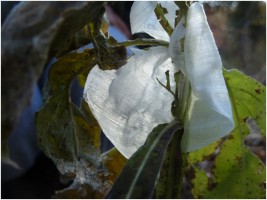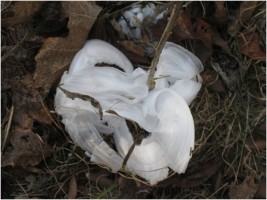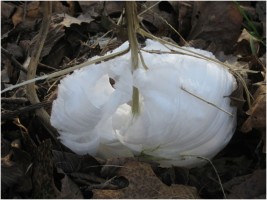By Bob Kipfer, Springfield Plateau Chapter of Missouri Master Naturalists
 Have you ever heard of “frost flowers“? If so, you had to get out early in the morning during the first few hard frosts. Frost flowers, also known as “ice ribbons,” are formed by super-cooled water being extruded through plant stems and freezing the minute they hit the cold air. They are beautiful, delicate and transient, destined to disappear when the temperature rises, or sooner if the sun hits them for a few minutes.
Have you ever heard of “frost flowers“? If so, you had to get out early in the morning during the first few hard frosts. Frost flowers, also known as “ice ribbons,” are formed by super-cooled water being extruded through plant stems and freezing the minute they hit the cold air. They are beautiful, delicate and transient, destined to disappear when the temperature rises, or sooner if the sun hits them for a few minutes.
Frost flowers occur regularly on the stems of White Crownbeard (Verbesina virginica), and Yellow Ironweed (Verbesina alternifolia), as well as dittany (Cunila origanoides). These are native species found in much of the eastern US, usually found in disturbed soil and along roadsides.
 There are a few vague reports of finding frost flowers on other plants, mainly coming from Europe. I am trying to compile a list of other plant species that produce frost flowers, no matter how small the “blossoms.” It is important to be able to identify the parent plants which may otherwise be unrecognizable late in the season. As members of the Master Gardener organization, you know your plants and likely have a wide variety in your plantings.
There are a few vague reports of finding frost flowers on other plants, mainly coming from Europe. I am trying to compile a list of other plant species that produce frost flowers, no matter how small the “blossoms.” It is important to be able to identify the parent plants which may otherwise be unrecognizable late in the season. As members of the Master Gardener organization, you know your plants and likely have a wide variety in your plantings.
Here Is Where You Come In: Visit your garden early on the morning of the first or second hard frost (below freezing through the night at temperatures below 28 degrees F) and look around the base of your plants. If you see ice ribbons on other new plants, identify the plant, preferably by genus and species, and if possible photograph the frost flowers – even with your phone. Then email me with your findings at frostflowers@sbcglobal.net. Your findings and pictures will be posted on a new blog at Frostflowerstudy.blogspot.com anonymously or with attribution as you chose.
I am a retired physician, involved in both Missouri Master Naturalists and Friends of the Garden. I have been in frequent contact with several experts from Michigan to Texas who have published information on frost flowers. Their papers are found below, along with frost flower pictures.
 Reports of your discoveries can expand our knowledge of these wondrous and mysterious frost flowers. Consider: no planting, fertilizing or watering, just an extra cup of coffee or tea with a warm coat for a 5 minute brisk walk in your own garden… and all in the name of science!
Reports of your discoveries can expand our knowledge of these wondrous and mysterious frost flowers. Consider: no planting, fertilizing or watering, just an extra cup of coffee or tea with a warm coat for a 5 minute brisk walk in your own garden… and all in the name of science!
Check out the following resources for more information on frost flowers:


Last year I saw a large group of frost flowers near the edge of Mirror Lake in Shaw Nature Reserve. Unfortunately I didn’t have a camera at the time. They were fascinating. I’d seen pictures before but to see the real thing was great.